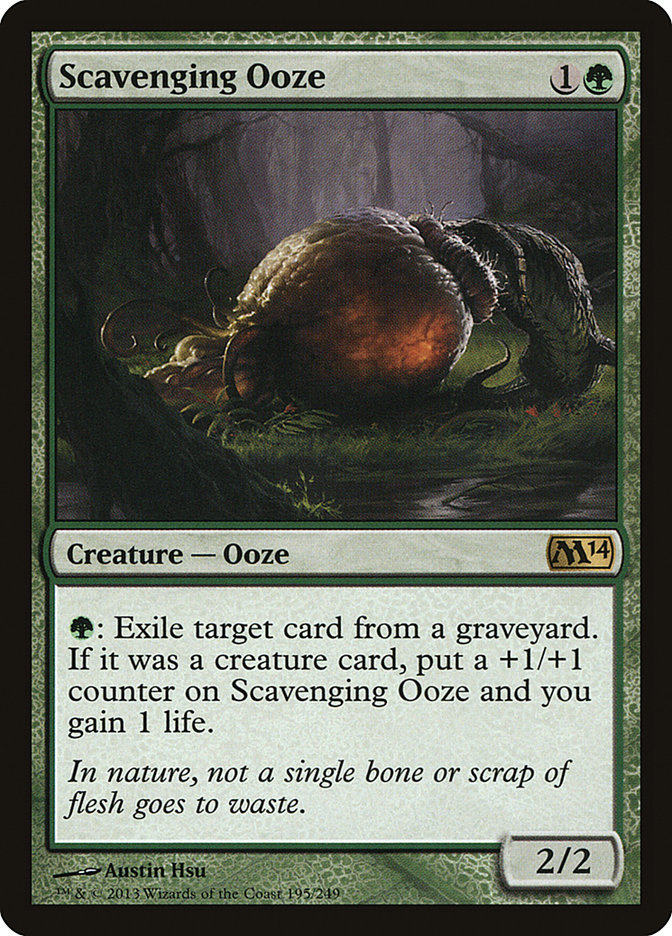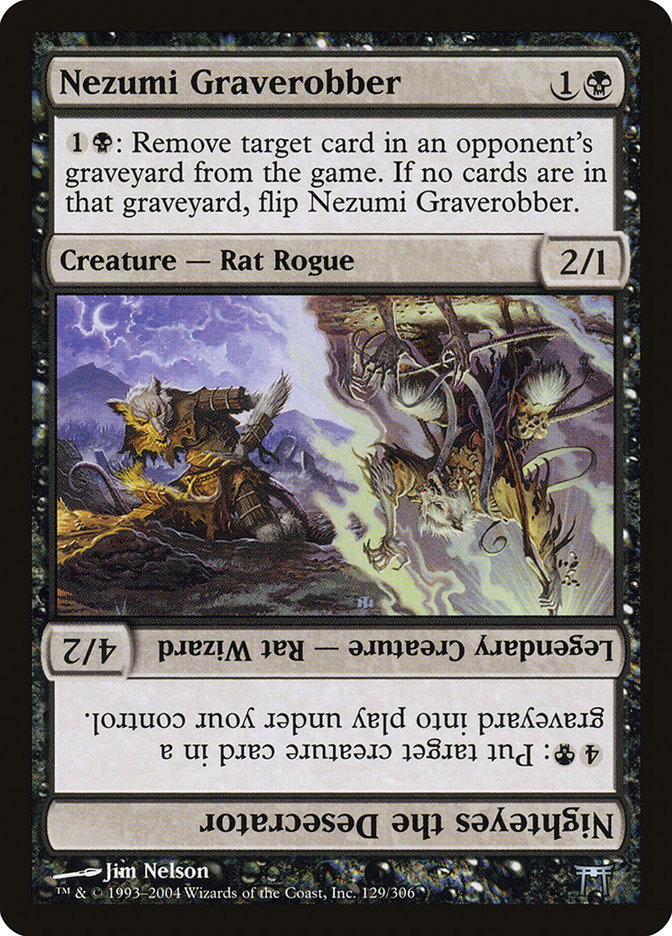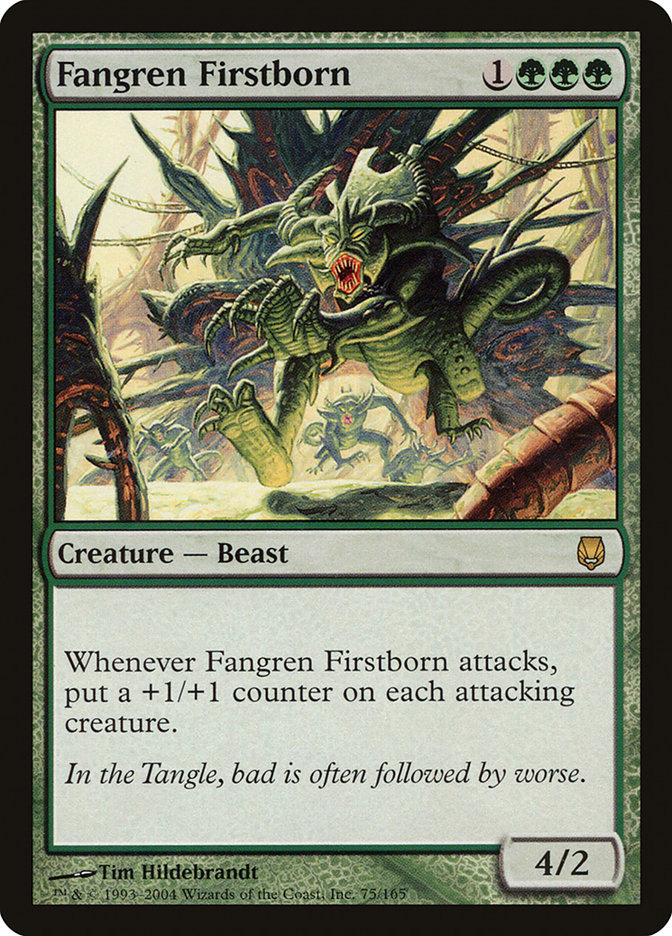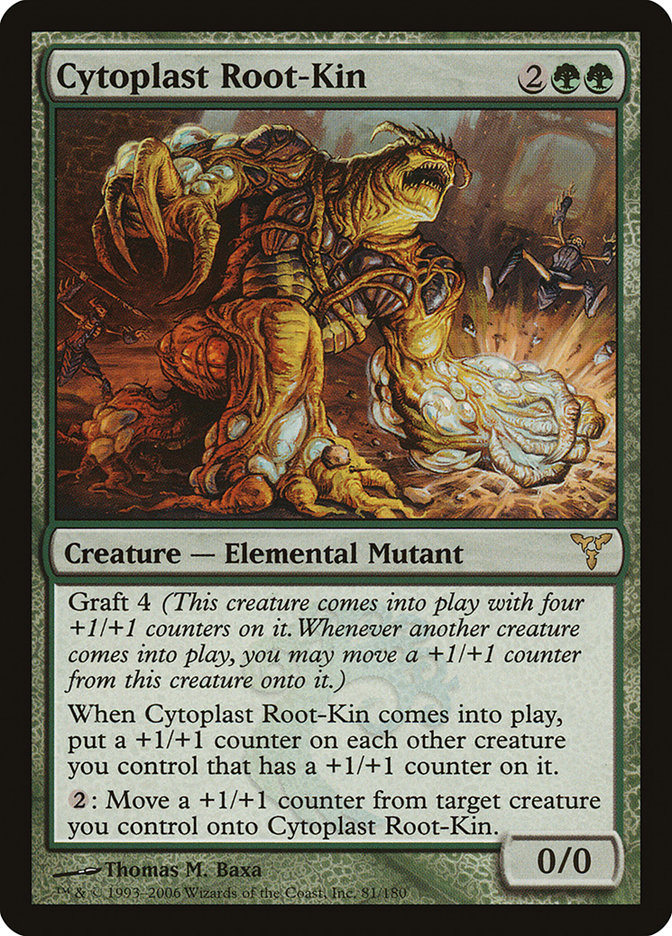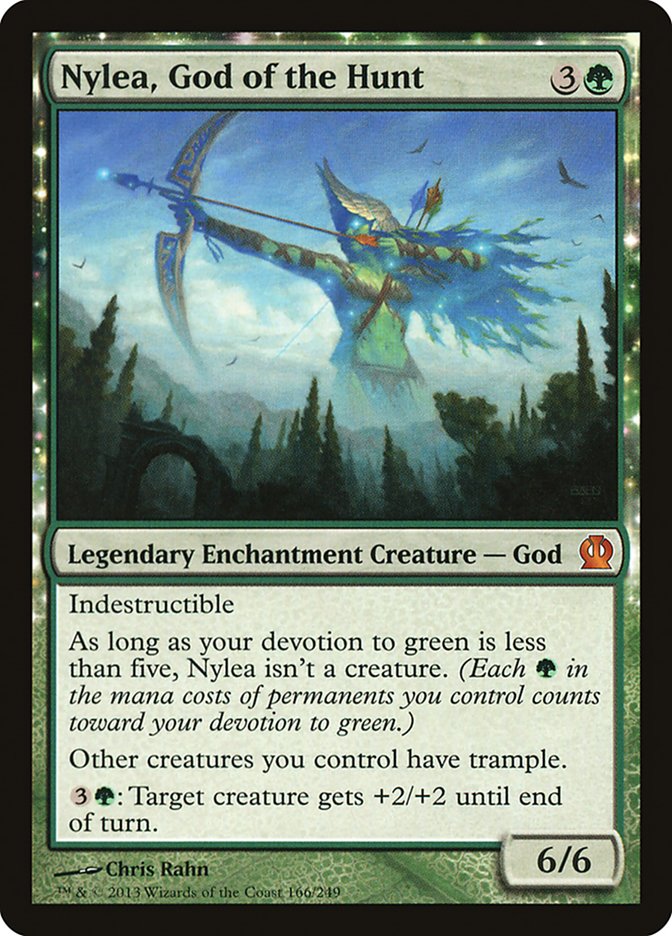
Two weeks ago, I asked for some input into picking a new Commander for me to build a beatdown deck around. I put up a few good choices that I’d find intriguing, and Skullbriar, the Walking Grave was selected by a pretty convincing margin – there’s just something about an aggressive Golgari beatdown deck that draws interest, I guess. Skullbriar is typically built Voltron-style, trying to play it and immediately fill up on creature buffs that push damage through quickly in order to hit multiple people with that oh-so-lethal twenty-one Commander damage before they really know what hit them. Sometimes it’s an all-in enchantment deck, the Commander version of the Slippery Bogle deck from Modern, and there’s not much surprise to anyone when one or more Swords come down to give Skullbriar protection from two colors, +2/+2, and two combat-related triggers to boot.
Less often, Skullbriar is just one part of a robust beatdown deck, and we’re going to try and go for that here – and sometimes a Proliferate-themed deck is built around the +1/+1 counters that Skullbriar naturally accumulates, or some other semi-“Tribal” deck built around maximizing counters in your creature base and then using narrow, niche cards to try and pull of tricky shenanigans all-too-quickly. (Things like Solidarity of Heroes that otherwise would never see the light of day might actually work in this context, and stranger things have been known to happen in this format.)
What I find most intriguing about Skullbriar is his memory. Sure, in the context of a beatdown deck it’s pretty cool to have a Slith Firewalker that deals Commander damage at the helm, but as far as building a deck that will do powerful things all up and down the mana curve, the compelling thing to me is that Skullbriar’s counter-accumulation trick stays with him when re-played, so that attack on turn two will keep Skullbriar relevant on turn ten. No matter how much you have to pay for him after he’s died a couple of times, the Slith ability plus the retained counters will help make sure that Skullbriar is a reasonably-sized creature for whatever point of the game we’re at.
We can take advantage of that superpower very well if we try, and that will let us build a powerful deck based on aggressive pressure all up and down the mana curve – one that isn’t a one-trick pony, since the ability to build resources while we’re doing it will give us plenty of cards in hand to work with and thus lots of stuff we can use to mess with the opponent or rebuild with when our stuff gets broken. Both green and black are good at card drawing in Commander, even if blue does it best, so we’ll build robustly for the mid-game instead of hyper-focusing on the early game as so many Skullbriar decks try to do. Rather than try and compress the game into as few turns as possible by cheap tricks like Hatred and Berserk, which are cool when you pull them off the first time and then just not when it comes up the second through hundredth time, we’re going to build a deck that likes to attack early and often but is capable of doing something with all of that pressure even as opponents try to stop them.
A Firm Foundation
A solid manabase is very important here, because we want to always have BG on turn two – failure to do so will result in everything we’re trying to accomplish falling out of whack later in the game. We’re going to want some spell-like functions in our deck as well, a good variety of lands that affect creature size or otherwise alter combat if we want them – Shizo, Death’s Storehouse seems especially potent here, as Fear is a very strong evasion ability (and unlike the more-generic “Intimidate” ability that we see these days, this doesn’t let green creatures block Skullbriar just because Skullbriar is green). We want to hit our first five land drops on time and hit our sixth land drop at some point consistently as well, and after that we don’t really need that much mana and we can try and bend it towards other purposes – like card drawing, which would make up for having more lands than we really need to cast our spells, or beneficial abilities that give us some value back in those cases where we’re flooded on mana.
For pure dual lands, we get access to the following:
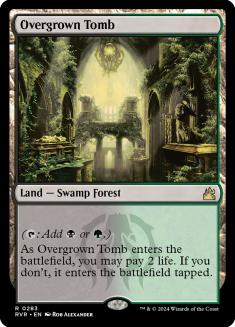
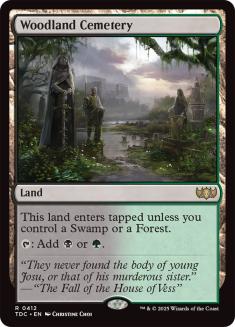
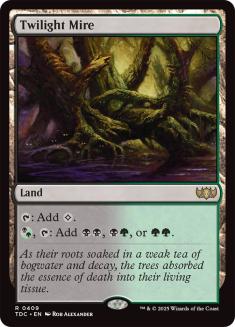
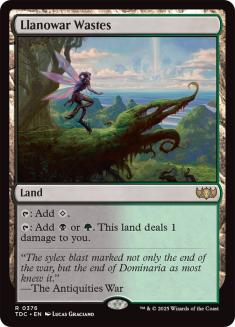
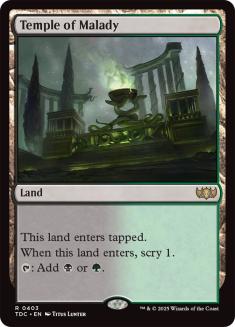
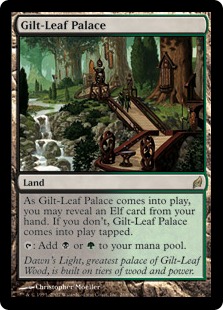
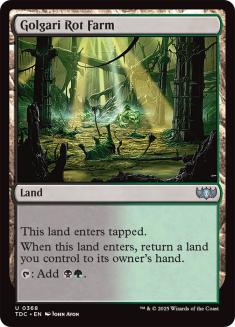

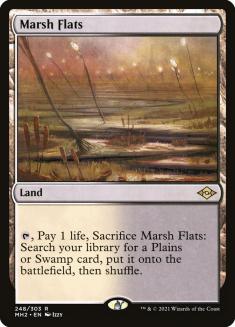
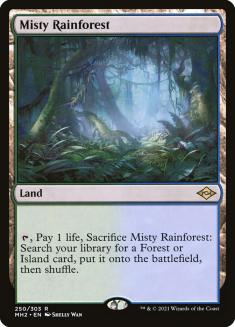
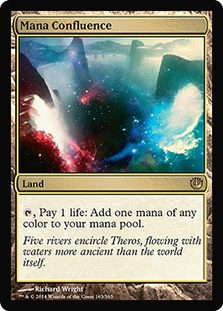
The fetchlands we’ll consider “full” duals thanks to Overgrown Tomb, even though the second fetchland won’t be able to find a second dual land – we don’t really need to concern ourselves with the second one, it’s that fixing we’re leaning on for turn two that requires our attention. Purists can include the Bayou somewhere, but as it is I try to build for a “reasonable” price point, and have whittled my big Commander box down accordingly – no more Revised dual lands, they’re fancy but the price creep gets in the way of me finding Commander interesting still. City of Brass would be a reasonable consideration as well, but unlike Mana Confluence it can’t tap for mana pain-free with an Urborg out, and Golgari Guildgate was the least-interesting of the dual lands that came into play tapped – we’re never going to use its Gate-ness as a feature, and at least Gilt-Leaf Palace will come into play untapped once in a while (though we are rather Elf-light).
Next up we have the utility lands:
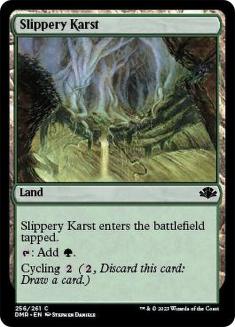
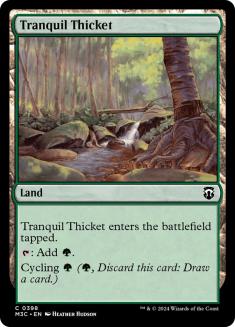
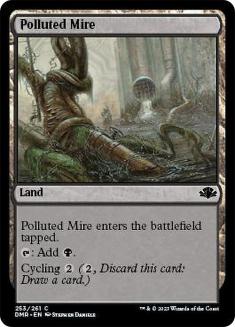
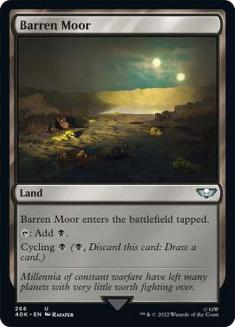
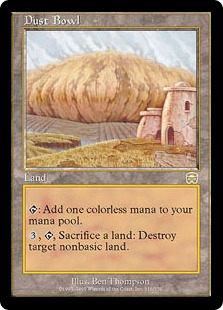
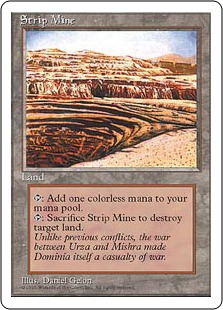
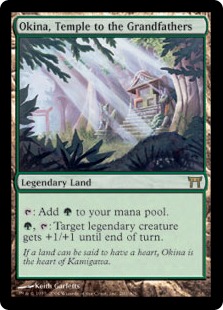
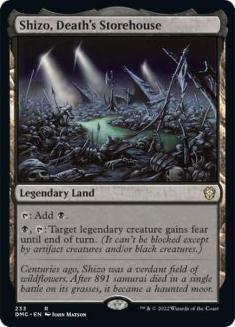
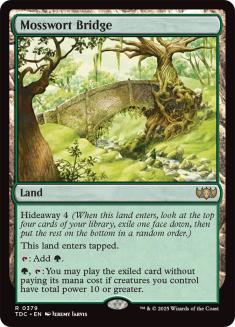
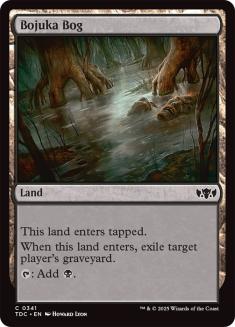
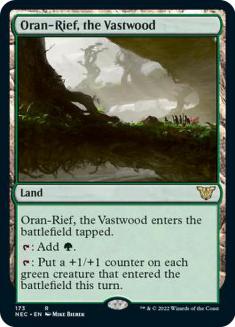
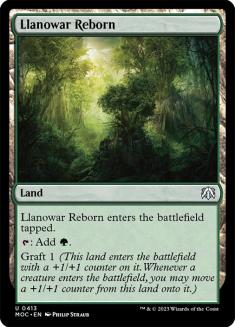
Each of these has some sort of utility in the middle or later stages of the game, even if that utility is ‘just’ being able to cash it in for another card instead of being stuck having drawn a land that turn. Llanowar Reborn’s counter will be a permanent addition on Skullbriar over multiple lifetimes and costs nothing to graft the counter over on turn two, and Oran-Rief will have the possibility of putting a counter on Skullbriar multiple times thanks to that Skullbriar’s retained memory tricksiness. These lands also interact fairly favorably with Life from the Loam, as do the fetchlands from the dual land base, so we’ll just need a little more for it to work with and it’ll be a solid resource-generation card in the earlier stages of the game and a powerful card draw effect later on – if we can get that while only relying on lands we’d be happy to play anyway, so much the better!
Our final four additions are chosen with that in mind:
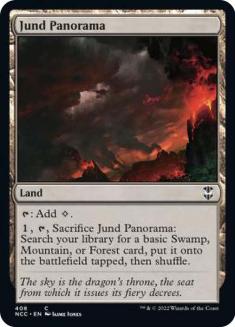
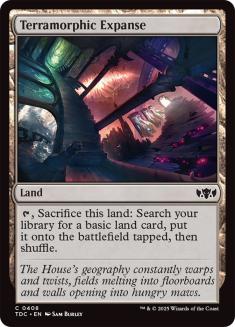
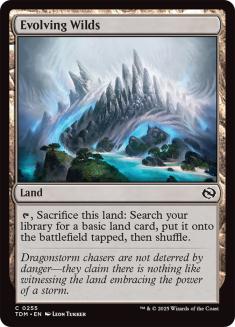
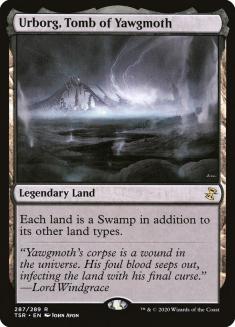
Urborg is “just” a good addition, allowing any green land to tap for black mana and having the side effect of letting Mana Confluence or a fetchland tap for mana without needing to put any life into them first… or even letting Terramorphic Expanse and Evolving Wilds provide mana the same turn you play them for once. Jund Panorama is not great because we want to keep ourselves limited on how many colorless lands we play – drawing one won’t help play Skullbriar on turn two, so they have a real cost – but it works with Life from the Loam or any similar style of effect and comes into play untapped, so it’s a good addition alongside Terramorphic Expanse and Evolving Wilds. We round the deck out by adding our basics, in this case that’s six Forests and four Swamps, giving us access to twenty-six green sources and twenty-three black sources. We’re going to need a bit more green mana than we do black in order to get rolling and are more likely to have color-intensive green cards than black ones, so this balance fits our costs effectively.
Enabling Victory
Usually I tie artifacts in with lands since they tend towards being mana sources in most builds, but in this deck we want to start dropping threats on turn two with Skullbriar and then make our next few creature drops as we march up the curve – a three-drop for turn three, a four-drop for turn four, and so on. We’re not trying to skip turns two through four in able to play a six- or seven-drop on turn five, as can be quite typical in this format, so we’re going to play just the most powerful of the mana rocks – Sol Ring – and the rest of our artifacts will be part of our spell base. So we’re going to look at the support spells all together, as there will be a significant overlap in what we’re trying to accomplish there… and so long as we’re naming obvious Commander staples we’re going to play and not have to explain even a single thing about, let’s get that Demonic Tutor out of the way while we’re at it.
First up we have the obvious and inevitable Skullbriar buffs – though I suppose some of them are the less-obvious choices, as this deck doesn’t “just” want to be “drop the best Sword of X and Y on Skullbriar and roll hard.” In fact, depending on how you rate the Swords, I’m playing either the third- and fourth-place copies or the bottom two out of this cycle of five; I tend to put Sword of War and Peace third on the list, behind Sword of Feast and Famine and Sword of Fire and Ice, but I can see how others place it last because they don’t really value the damage potential the card has in our hugely hand-size-relevant format.
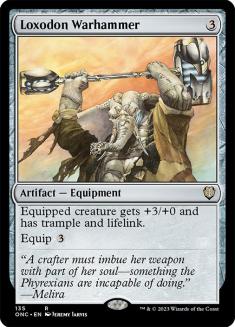
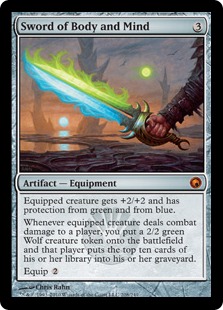
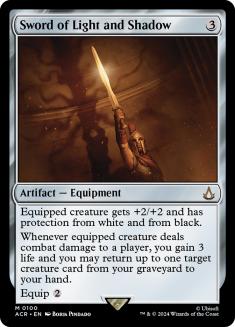
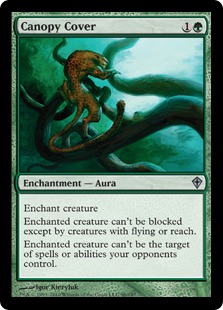
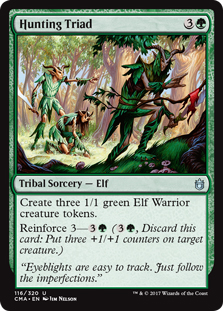
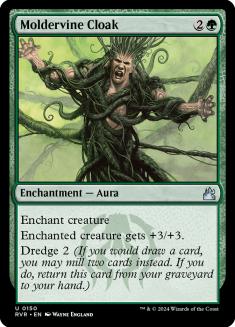
Our Sword choices are based on the context of the deck – Body and Mind provides aggressive pressure and we’ve got just a wee bit of shenanigans going on as well when it comes to potentially interacting with an opposing graveyard, and a free Wolf each turn is very good for our overall plan. Sword of Light and Shadow buys back a spent threat each turn, letting us still have action as the game hits the grindy middle stages – and while it puts a card in our hand like Fire and Ice does, Light and Shadow lets us choose the card, which I think makes it better for our purposes here as we try to keep building up pressure.
Canopy Cover is obvious thanks to the cheap cost of the benefits it provides and Loxodon Warhammer provides both Lifelink and Trample, which will both help us connect for damage and get away with not really focusing very hard on our opponents’ damage potential at the same time. Moldervine Cloak is just a highly mana-efficient buff that comes directly on-curve right after Skullbriar, plus it can be re-bought from the graveyard whenever we happen to want that particular effect.
The weird one is Hunting Triad, but we do want Elves for our Gilt-Leaf Palace sometimes, tokens for our damage-building effects (as we’ll soon see), and those Reinforce counters will last forever on Skullbriar thanks to his unique memory retention skills. It’s a weird one, sure, but it fits very well nonetheless.
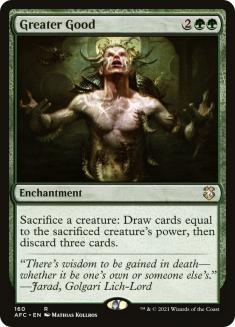
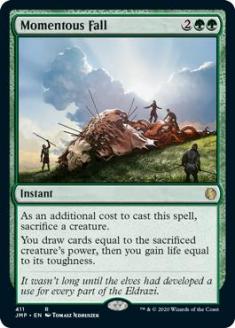
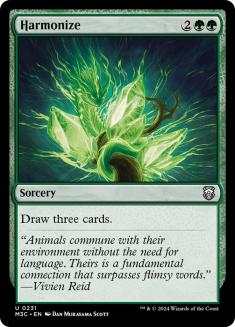
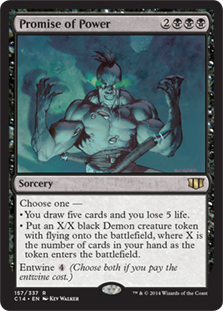
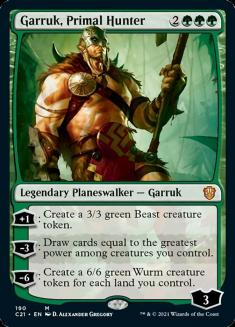
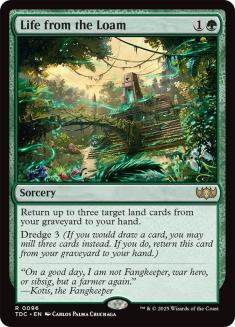
This package is our card-drawing effects, though a few of them do other things as well – Garruk makes free 3/3 tokens, Promise of Power is a late-game threat in addition to card drawing if we’re flooded to the point of paying the Entwine cost, and Life from the Loam can recur spell-like lands, not just build resources with fetchlands and provide card drawing with cycling lands. Each of these will help keep the cards flowing to our hand at a reasonable price, and we’ll supplement that side of things in our creature base as well.
We do want some more recursion going on than Greater Good and Life from the Loam, however – this is Commander, we can’t just try and beat down and assume everything is going to work out all right. We’re going to need a little bit more going on than that if we want this to end in our favor, and that means being able to get multiple cards’ worth of value out of any individual piece of cardboard.

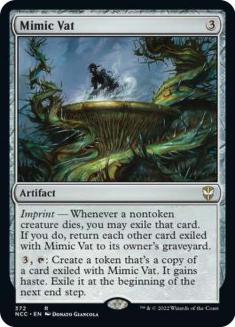
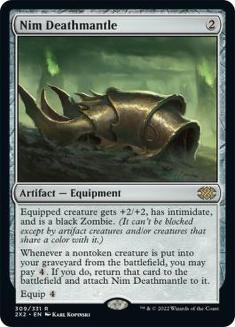

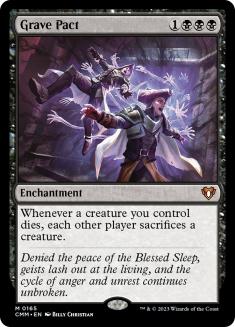
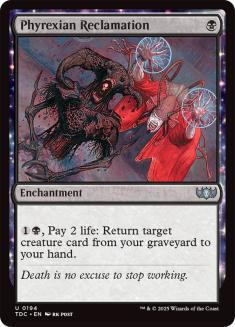
Crucible of Worlds will let us get free resources every turn starting potentially even on the turn we cast it, and it can recur our utility and advantage lands in order to get more spell-like effects out of our mana drops – or we can just play it while we have a land-light hand on turn three and make every land drop from turn four through effectively infinity as far as our mana needs are concerned, given a single fetchland of whatever variety. Nim Deathmantle and Mimic Vat serve to keep the pressure on even as we run face-first into the format’s sweepers while Grave Pact should let us attack with impunity and always come out ahead on the deal, keeping opposing boards from growing so entrenched that we can’t break through. This is another card that rewards us for having tokens, though we’re not going to try and focus on tutoring for this or really being able to break it so that we’re the only player able to keep a creature alive; it’s just here to do a lot of heavy lifting so we don’t need to play sweepers that kill our own stuff or dedicate a lot of our cards towards being able to kill an opponent’s creatures.
Bow of Nylea offers a good static ability when attacking – Deathtouch means that opposing creatures won’t be able to beneficially block our attackers even if they are outclassed when we turn them sideways – and can provide a dash of recursion by restocking our library, a bit of removal against small fliers, and even a repeating buff to Skullbriar thanks to the +1/+1 counter side of the card and Skullbriar’s long memory for such things. And our last choice, Phyrexian Reclamation, is part recursion and part card drawing – but a slot I agonized over, really wanting Whip of Erebos instead thanks to the fact that the passive lifelink is a very strong ability and the ability to put a creature directly into play so it could attack immediately was very compelling. Phyrexian Reclamation is cheap to cast and cheap to use, after all, but that low cost is overshadowed by the casting cost of the threat you’re buying back – Whip of Erebos asks for more mana up front, and the threat isn’t permanent, but you don’t have to spend any more mana past that point: you just tap to attack.
(And I like tapping to attack here. A lot.)
Ultimately I decided on Reclamation here because we need to have at least a few ways to potentially put Skullbriar back in our hand from the graveyard in case we need to break the chain of memory for once – while being quashed with -1/-1 counters is not something we expect to have often, we do need to recognize that Skullbriar’s fantastic memory for such things gives it a second way to be rendered useless besides tucking. The only way to break that memory is by putting the card into our hands from one zone or another, and Phyrexian Reclamation does that repetitively and at an attractive price. Most of the time we’ll be using it to buy back other threats while Team Skullbriar keeps it trucking, but wanting to be able to find an effect like that when we need it helps inform our card choices.
Our next package – “the Overrun” – is just two cards: Overwhelming Stampede and Garruk Wildspeaker. Garruk obviously does a variety of other things besides potentially fire off an Overrun, and we like all three modes of the card and our ability to access them reliably at a time of our choosing – sure, we’re of the right color identity to play Garruk Relentless and that Overrun effect can potentially be even bigger, but that card needs to take damage somehow and flip, then gain enough loyalty to be able to fire it off – Garruk Wildspeaker is tokens when we want it, mana when we need it, and it can effectively be an Overrun with Suspend: 1 if that’s what we are looking for instead.
Overwhelming Stampede is technically less consistent than Overrun – when it resolves, the buff can be anywhere from zero to two instead of the tried-and-true three of Overrun – but the ceiling is also much higher too. Skullbriar might get quite large over the course of a game, so this will be +large/+large instead of +3/+3; if we cast Skullbriar on turn two and attack unimpeded three times as we plan to, just playing this on-curve on turn four will be +4/+4 instead of Overrun’s +3/+3. The overall volatility this card implies – it can be smaller, not just bigger – should be very small compared to the size our Commander should be at and the size of our monsters up at the top of the curve. It’s not as good at pumping just tokens, but that’s not the role we’re asking it to fill, we want it to pump a mixed team of tokens and fatties to swing through for lethal (… possibly against multiple opponents). And we don’t want to cheese anyone with poison damage, in case anyone thought Triumph of the Hordes was the better Overrun.
So now we’ve just got a bit of removal to add, and we want it to be cheap – in order to compensate us for ‘just’ trading one-for-one with an opposing card – and flexible, if possible. The cheaper it is, the less-flexible it needs to be, and we’re willing to accept a weak removal spell that has a lot of flexibility over a catch-all answer for that fifth slot, as once we’ve got four (and supplemented it somewhat in our creature base) we’re able to bank on drawing one of them over the course of a game in which we need one.
We’re going to go with these five:

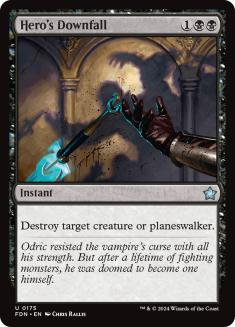
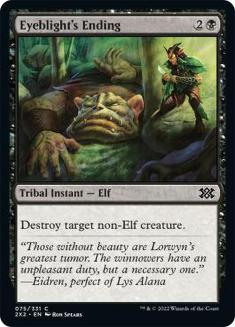
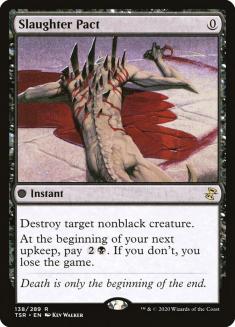
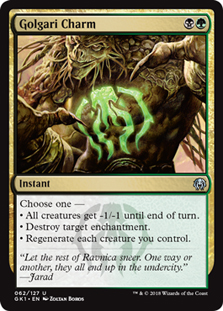
Golgari Charm can regenerate our team from a sweeper spell or clear a problem enchantment, not just potentially wipe out a token army, so it gets the nod for its unique attributes rather than as ‘just’ a generic and reliable removal spell. Slaughter Pact comes at the ideal price of “free,” and the nonblack limitation is meaningful but not big enough that it should concern us. Both Putrefy and Hero’s Downfall can target another permanent class that could be giving us trouble instead of a creature if that’s what we need to kill. Eyeblight’s Ending has no such flexibility, and we could have the maximally-flexible Beast Within in its stead, but we’re actually rumbling with creatures around the 3/3 size, so we don’t want to give an opponent one as we clear their threat. Eyeblight’s Ending might as well just say “Destroy target creature” given that the non-Elf clause should rarely protect a threat we need to clear, and it even counts as an Elf for Gilt-Leaf Palace, which is good because we’re going to find only a few of those in the creature section and any little increase helps. Our two “Tribal – Elf” spells may not matter often, but having that attribute for free for no particular reason may just matter enough.
The Beatdown Team
We could, logically, filter these next cards like we did the spells – what are they there to do, how are they similar to other things we’re trying to accomplish, and how do they weave together to become part of a greater whole. Inquiring minds want to know, after all, and that’s a reasonable way to tell the story of the deck. But it’s not the best way to tell the story of this deck – we’re focusing on beatdown the old-fashioned way, not with creature buffs on Skullbriar and double-fisted Sword of X and Y-wielding prowess that makes him practically unblockable and amps him up into the stratosphere as far as dealing that lethal 21st Commander damage is concerned. And that means we’re going to look at our next additions by mana cost, as our plan is to play Skullbriar on turn two then make our drops consistently as we go through the third, fourth, fifth and sixth turns so that we’re applying a lot of pressure very quickly and deal not 21 damage on time but 40. We’ll still always have the option – and the ability – to deal lethal Commander damage to an opponent who’s poised to gain enough life to get out of range of our beatdown plan, but our early focus is going to be on playing the best drops we can at each slot on the mana curve and pressuring the opponent both early and consistently.
1cc Creatures:
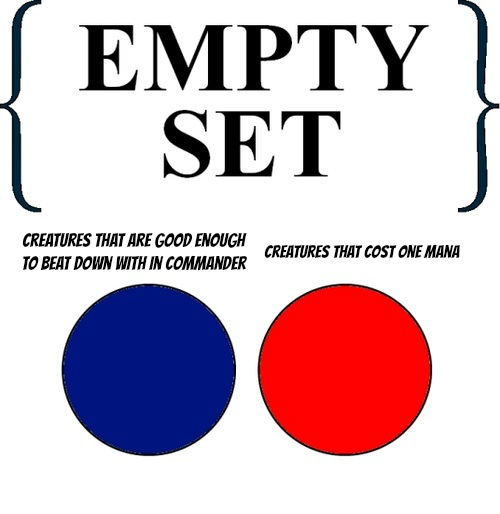
2cc Creatures:
Two mana is where Skullbriar lives, so a two-mana creature is going to be added mostly for its utility, not because we’re using it to make our drops on-curve. There are just three that I wanted here in that role, and each will be able to shine later on in the game when they have enough mana to work effectively. Two provide utility we need to counteract recursion, while the third is there for a mix of evasion and token generation that can supercharge our deck after Skullbriar’s had some time to work. They are:
3cc Creatures:
This is where we’re really planning to start making our creature drops, and we want these to apply pressure, build up our resources, and be very efficient attackers (if possible). We’ll trade off some efficiency for late-game power, as appropriate, but we want these creatures to be selected around getting in for damage effectively in the early game.
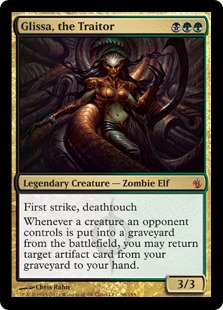
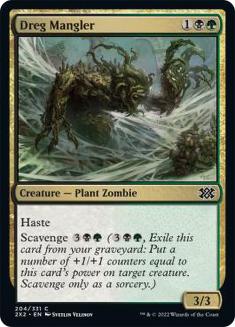
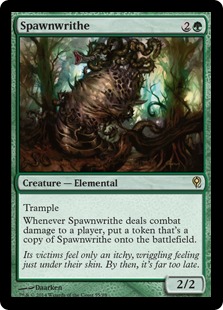
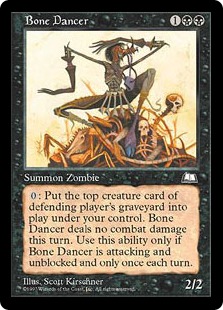
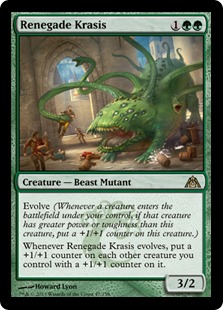
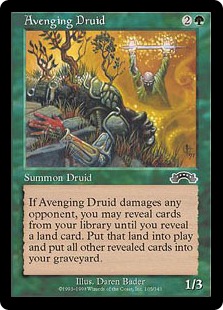
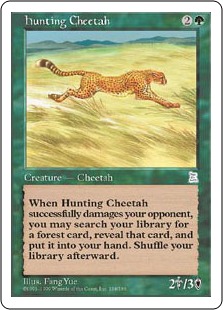
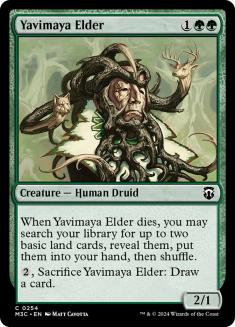
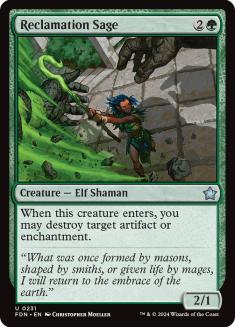
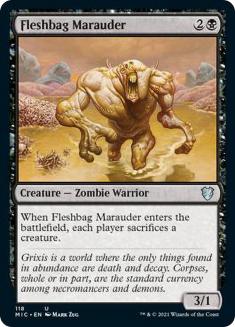
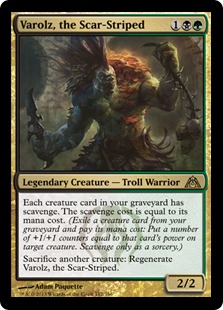
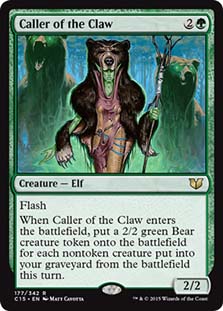
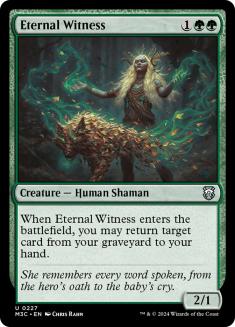
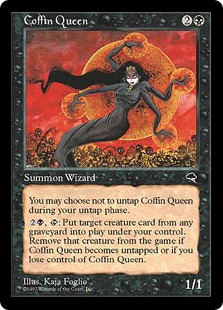
We have a good mix of creatures here for giving us extra resources to work with, beating down effectively past blockers (can’t beat Glissa for that, with First Strike plus Deathtouch!), and late-game utility – we’re even trying to mix things so we get multiple of these effects together at the same time, like Bone Dancer’s ability to remain relevant far later in the game if you’re able to sneak it across unblocked with any of the effects that give it some element of an unblockability clause. Heck, we’re not even building around her, and even Glissa can buy back a broken Sword! I particularly like Renegade Krasis here as a card I played in another narrow deck and have been seeking another home for, as it over-performed in my Animar build and will hopefully be just as strong alongside another Commander that loves +1/+1 counters.
4cc Creatures:
First we have the beatdown monsters:
We’re green-heavy enough that Nylea should turn on readily enough, and giving Skullbriar trample is something we want to do in general principle but don’t really want to spend cards on by itself. Fangren Firstborn pumps Skullbriar, itself, and the rest of the team turn after turn, working on our Overrun sub-theme and Skullbriar’s counter-memory effect while also just being a highly effective beatdown monster – and Cytoplast Root-Kin should at the very least give Skullbriar a pre-combat boost while being a 4/4 for strategic attacking purposes. Our other choices at this point in the curve have the card count on their mind one way or another:
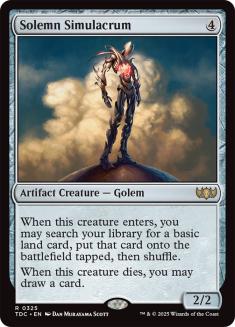
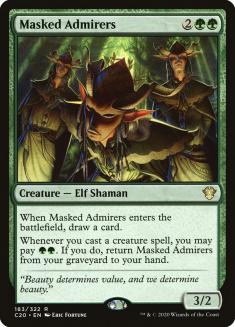
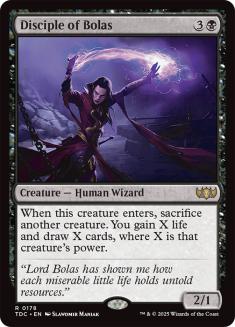
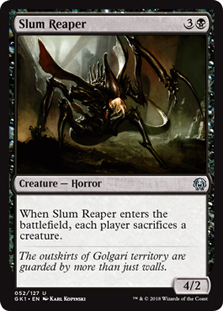
What we’re giving up in basic creature power and toughness, we get back through accessing other resources or getting an attractive rate while doing something we want – and maybe even a bit of recursion while we’re at it. Masked Admirers is a resource we can continue using turn after turn, and while a 3/2 body is not as relevant on turn twelve as it might be in the earlier stages of the game, being able to get more action out of a depleted hand and a board of just mana will keep you running when you’re out of gas.
5cc Creatures:

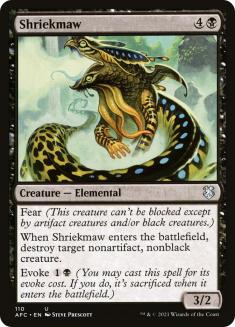
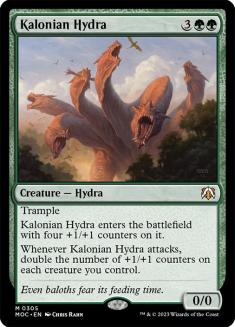
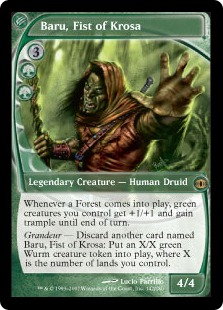
A bit more removal starts us off, but then we hit the high-impact attackers – Kalonian Hydra’s doubling effect can be quite potent indeed with Skullbriar, especially since it does the doubling before you deal combat damage, potentially ramping up to that lethal 21st point. Baru is the less-obvious addition, since he’s not usually played anywhere (and Grandeur looks particularly stupid in Highlander decks) – but getting a mini-Overrun whenever you play a Forest is enough reason to give him the nod. While we may have only a few actual Forests to work with, the other cards we’re playing have made it so that we’re very good at finding them when we want to and may even let us save things up so we can get multiple triggers in one combat thanks to fetchlands. This is almost a reason to miss that absent Bayou, but the price range for cards I’m content to play in this format has been steadily falling recently and I see no great reason to go chasing any of the Revised duals again anytime soon.
But six mana is where we hit the top of our curve…
6cc Creatures:
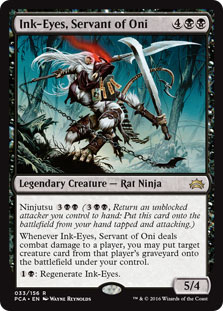
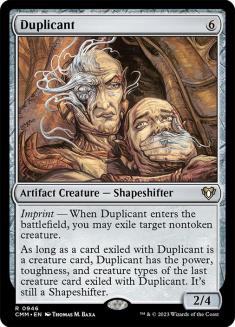
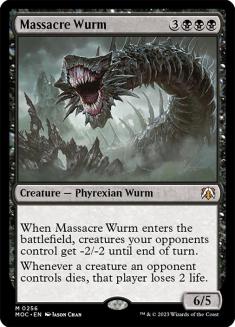
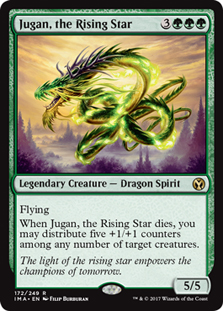
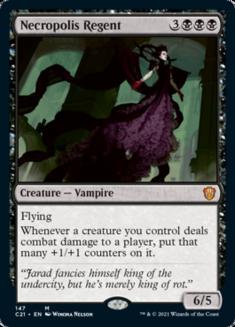
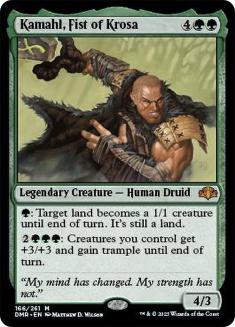
Ink-Eyes is a virtual five-drop, and one that can massively build pressure thanks to the saboteur clause of reanimating an opponent’s best creature. Duplicant and Massacre Wurm are both fatties that count as removal, and in fact Massacre Wurm will sometimes be a killing blow against the opponents who are best at shutting us down: those nice people who like to flood the board with token creatures to keep us from getting our damage across. Jugan is one of those cards I feel obligated to put to work in the few narrow cases where it would actually be good, as the worst of the Kamigawa dragons by a wide margin will actually do good work for us here – sure, Kokusho would probably be better, but when we get to put those counters on Skullbriar and keep using them over and over again that synergy will be dramatically more powerful than the five-point life-drain was. The Kokusho-drain will be powerful more often, especially thanks to the Commander-scaling of all Syphon Soul effects, but that in and of itself isn’t compelling enough reason to include it. We’re not so tight for spots that this was a one-or-the-other decision, I just find Jugan interesting here and do not find Kokusho very interesting at all.
Necropolis Regent amplifies any creature, not just Skullbriar, so again we have a solid overlap of good Overrun-style effects and things that make Skullbriar especially dangerous. And our last addition “just” casts Overrun by himself turn after turn while putting negative pressure on any opponent looking to deploy a mass removal spell. Everyone knows that any untapped green mana equals their own lands dying in the effort too, so this will help keep the Wrath-happy folks off of your back so long as you keep some mana up to punish them for stopping you. We won’t be using Kamahl in any of the degenerate ways people tend to fall into – we’re not animating opposing lands and actively killing them ourselves – but that’s the jerk-face way to use the card anyway. We like the part where we get to beat in for massive damage and even put excess lands into the fray while we are flooded, and the part where someone could Wrath but doesn’t because they can’t afford to cripple themselves by wiping our board. And Team Overrun has one last member, our 99th card, the only card in our entire deck costing more than six mana:
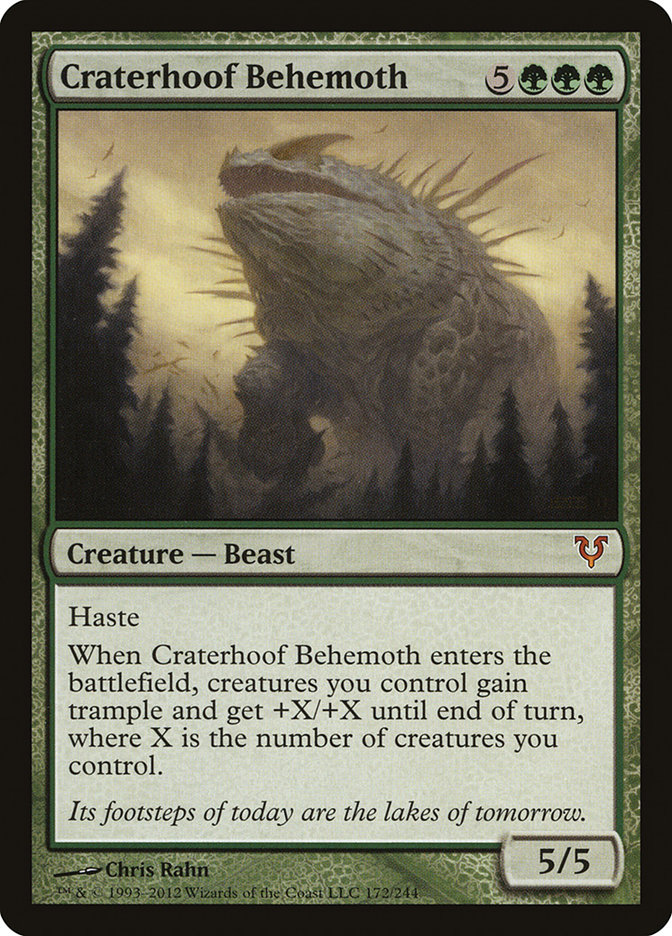
No surprises really there, and no guesses were needed to predict that given how the deck had been shaping up so far. Maybe it’s boring, maybe it’s overused, but we’re not abusing it – no Soulbonding it with Deadeye Navigator and amping up that trigger five or six times in a turn, we’re just gonna Overrun for lethal and smash everyone in the face. We’re just going to do it once, and that just once will usually be good enough. (Sure, we can buy it back from the graveyard and repeat if we need to, but should we really expect that to come up? I doubt it. And if somehow this gets imprinted on a Mimic Vat… game over man, game over!) We’re building a mono-dimensional aggressive deck and can’t shy away from the powerful cards that would fit our strategy just because everyone else plays them too, we’re going to play enough other things no one else is touching that we shouldn’t sweat the hipster effect. We’re playing Hunting Triad, Korozda Guildmage and Jugan, the Rising Star; we don’t need to bow to the social pressure of “but everyone is playing that card” because there are plenty of supposed stinkers we’re happy to game with in our 99.
Putting it all together, we get the following:
Creatures (35)
- 1 Ink-Eyes, Servant of Oni
- 1 Solemn Simulacrum
- 1 Jugan, the Rising Star
- 1 Bone Dancer
- 1 Coffin Queen
- 1 Nezumi Graverobber
- 1 Kamahl, Fist of Krosa
- 1 Caller of the Claw
- 1 Eternal Witness
- 1 Fangren Firstborn
- 1 Yavimaya Elder
- 1 Duplicant
- 1 Hunting Cheetah
- 1 Avenging Druid
- 1 Cytoplast Root-Kin
- 1 Baru, Fist of Krosa
- 1 Masked Admirers
- 1 Shriekmaw
- 1 Spawnwrithe
- 1 Fleshbag Marauder
- 1 Acidic Slime
- 1 Glissa, the Traitor
- 1 Massacre Wurm
- 1 Scavenging Ooze
- 1 Craterhoof Behemoth
- 1 Disciple of Bolas
- 1 Dreg Mangler
- 1 Korozda Guildmage
- 1 Necropolis Regent
- 1 Slum Reaper
- 1 Varolz, the Scar-Striped
- 1 Renegade Krasis
- 1 Kalonian Hydra
- 1 Nylea, God of the Hunt
- 1 Reclamation Sage
Planeswalkers (2)
Lands (37)
- 1 Strip Mine
- 6 Forest
- 1 Llanowar Wastes
- 4 Swamp
- 1 Slippery Karst
- 1 Polluted Mire
- 1 Shizo, Death's Storehouse
- 1 Okina, Temple to the Grandfathers
- 1 Tranquil Thicket
- 1 Barren Moor
- 1 Dust Bowl
- 1 Golgari Rot Farm
- 1 Overgrown Tomb
- 1 Terramorphic Expanse
- 1 Urborg, Tomb of Yawgmoth
- 1 Llanowar Reborn
- 1 Gilt-Leaf Palace
- 1 Mosswort Bridge
- 1 Twilight Mire
- 1 Jund Panorama
- 1 Marsh Flats
- 1 Misty Rainforest
- 1 Oran-Rief, the Vastwood
- 1 Verdant Catacombs
- 1 Bojuka Bog
- 1 Evolving Wilds
- 1 Woodland Cemetery
- 1 Temple of Malady
- 1 Mana Confluence
Spells (25)
- 1 Sol Ring
- 1 Demonic Tutor
- 1 Grave Pact
- 1 Crucible of Worlds
- 1 Sword of Light and Shadow
- 1 Promise of Power
- 1 Loxodon Warhammer
- 1 Phyrexian Reclamation
- 1 Greater Good
- 1 Life from the Loam
- 1 Moldervine Cloak
- 1 Putrefy
- 1 Harmonize
- 1 Slaughter Pact
- 1 Eyeblight's Ending
- 1 Hunting Triad
- 1 Canopy Cover
- 1 Momentous Fall
- 1 Overwhelming Stampede
- 1 Sword of Body and Mind
- 1 Mimic Vat
- 1 Nim Deathmantle
- 1 Golgari Charm
- 1 Bow of Nylea
- 1 Hero's Downfall

Unfortunately, I missed my first opportunity to play this last night at my local gaming store for Twenty-Sided Store’s Monday-evening Commander-fest, as I didn’t quite have everything for the deck in the Big Old Commander Box Of Doom – why it had the nine other buddy-lands but no Woodland Cemetery is beyond me, and a few of the less-frequently-seen cards like Bone Dancer, Hunting Cheetah and Fangren Firstborn had been on my mind but not made it into the box yet so I didn’t quite have everything near to hand. Fortunately, the StarCityGames.com Invitational is in my backyard this weekend – meaning I can ask them very nicely to put together a small care package of all of the things I’m missing for the deck and pick it up over the weekend.
Sadly, I’ll only be able to pick up some cards, though the reasons I won’t be able to attend and play this weekend are rather happy ones. While I’m qualified as a writer (at the same time as I’m only dubiously “qualified” because I’m a Commander writer), this weekend two of my favorite female gamer-folks are getting married and have asked me to attend, so I’m on a plane to Colorado for a wedding over the weekend – but I can pick the cards up first and bring my new Commander deck, potentially putting it to work in these fortuitous circumstances because I had the foresight of teaching their two sons to play Magic a few years ago.
More likely I’ll “just” get to battle with it next Monday for the first time – wedding weekends are chock-full affairs, after all, and it may very well be too busy to even try and fit a game in – but I’ll bring a few Commander decks anyway and see what happens. In the meantime I have another event to prepare for this Thursday evening before I go, so if you’re in New York City and potentially inclined, feel free to join me even though it doesn’t involve slinging brightly colored pieces of cardboard (and definitely not 99 of them).
Since I won’t be able to attend, I’ll be posting what I would have played on my personal Facebook page later this week, if you want to check in there and see something interesting (but not particularly earth-shattering… nothing quite like the oddity of my needing to hunt up Granger Guildmages for Legacy as from a few years back). Like everyone else I’m looking forward to the next Standard rotation, and my best-designed deck to play (Ichorid-less Dredge) is actually beyond my ability to play correctly despite having designed it myself – what can I say, complexity is a thing and it can bite you in the rear sometimes. Check in there Wednesday or Thursday if you’re curious what I’d do with 60 cards instead of 99 – I know that for Modern at least that garnered some curiosity.
Want to submit a deck for consideration to Dear Azami? We’re always accepting deck submissions to consider for use in a future article, like Jordan’s The Mimeoplasm deck or Jacob’s Oloro, Ageless Ascetic deck. Only one deck submission will be chosen per article, but being selected for the next edition of Dear Azami includes not just deck advice but also a $20 coupon to StarCityGames.com!
Email us a deck submission using this link here!
Like what you’ve seen? Feel free to explore more of Dear Azami here, in the Article Archives! Feel free to follow Sean on Facebook… sometimes there are extra surprises and bonus content to be found over on his Facebook Fan Page, as well as previews of the next week’s column at the end of the week!


